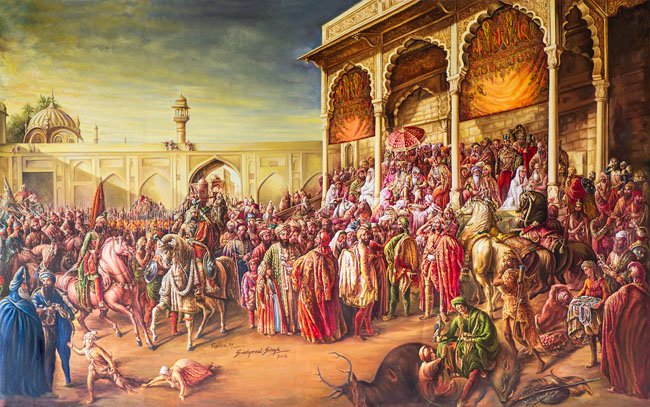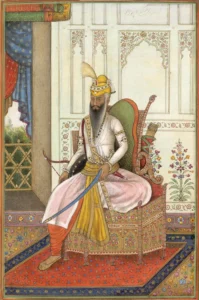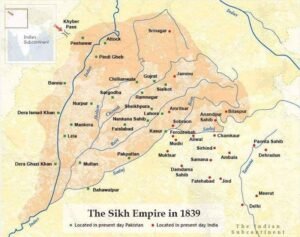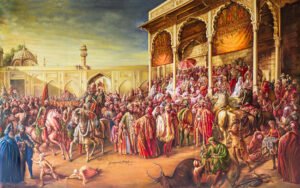The Rise and Fall of the Sikh Empire: Part 4 – The Rise of the Sikh Empire

“Ranjit Singh welded the warring misls into a formidable empire stretching from the Khyber Pass to the Sutlej. A secular ruler in a deeply religious age, he employed Hindus, Muslims, and Europeans alike, and ruled with tolerance, pragmatism, and vision.”
History of Sikhs Vol. 1 & Vol. 2
Khushwant Singh
The death of Ahmed Shah Abdali in 1772 marked a turning point in Punjab’s history. For decades, the region had been ravaged by Abdali’s nine invasions, leaving the once-flourishing land in ruins. However, without a common enemy, the loose confederation of Sikh Misls, which had previously united to resist foreign rule, found itself increasingly divided. Internal rivalries and disputes over territory, resources, and power began to weaken the cohesion of the Sikh military forces. The biannual assemblies of the Sarbat Khalsa, which once served as a unifying force, struggled to mediate between the competing factions.
It was evident that the era of the independent Misls was drawing to a close. Punjab, if it were to withstand foreign aggression and maintain its sovereignty, needed a single, unifying leader—a ruler who could consolidate the warring factions, establish a strong centralized state, and ensure stability for all Punjabis, regardless of religion or caste. That leader would be Maharaja Ranjit Singh, a visionary warrior-statesman who transformed Punjab from a fragmented land into a powerful and prosperous empire.

The Rise of Ranjit Singh
Born in 1792, Ranjit Singh was the son of Maha Singh, the chieftain of the Sukerchakia Misl, one of the most dominant military factions in Punjab. Even in his youth, Ranjit Singh demonstrated remarkable resilience, intelligence, and leadership qualities. At the tender age of 12, following his father’s untimely death, he ascended to the chieftaincy of his Misl. Despite his youth, he was fearless in battle, surviving an assassination attempt at the age of 13 by killing his attacker. His ability to command loyalty and navigate the turbulent political landscape of Punjab set him apart from other chieftains.
Ranjit Singh’s political position was strengthened further through his strategic alliance with the Kanhaiya Misl, one of the most powerful Sikh factions at the time. His marriage to Mehtab Kaur, the daughter of Sada Kaur, the formidable female leader of the Kanhaiya Misl, provided him with crucial military and political support. Sada Kaur, a fearless warrior and shrewd strategist, played an instrumental role in mentoring and assisting Ranjit Singh in his early campaigns.
Uniting Punjab: The Seizure of Lahore
Ranjit Singh’s rise to dominance began in 1797, at the age of 17, when he successfully repelled an invasion by Shah Zaman, the grandson of Ahmed Shah Abdali and ruler of the Durrani Empire. This victory earned him widespread recognition and respect among the Sikh chieftains and the broader Punjabi population.
In 1799, capitalizing on his growing influence, Ranjit Singh turned his attention toward Lahore, the historical and economic heart of Punjab. At the time, Lahore was ruled by three rival Sikh chieftains who had divided the city among themselves. Recognizing the importance of Lahore as a symbolic and strategic stronghold, Ranjit Singh launched a swift and decisive campaign to seize control. With the support of Sada Kaur and her forces, he entered Lahore, encountering minimal resistance. The citizens of Lahore, weary of the instability and infighting, welcomed Ranjit Singh as a liberator rather than a conqueror.
Having secured Lahore, Ranjit Singh solidified his claim to leadership by being formally crowned as the Maharaja of Punjab in 1801. His coronation marked the birth of the Sikh Empire, a centralized state that would govern Punjab for the next four decades.
Diplomatic Relations and Expansion
Ranjit Singh was not just a warrior; he was also a masterful diplomat. He recognized that to sustain his newly formed empire, he needed to navigate the complex geopolitical landscape of the Indian subcontinent. His two greatest external challenges were:
- The British East India Company, which had expanded its control over much of northern and eastern India.
- The Nepalese Kingdom of Gorkha, which had begun encroaching into Sikh territories.
Ranjit Singh engaged in diplomatic negotiations with both powers, securing treaties that ensured Punjab’s sovereignty. The Treaty of Amritsar (1809), signed with the British, established the Sutlej River as the boundary between the Sikh Empire and British-controlled territories. This agreement prevented immediate British interference in Punjab’s affairs while allowing Ranjit Singh to focus on internal consolidation and military expansion.

Military Reforms and the Rise of a Modern Army
Understanding the threat posed by European colonial forces, Ranjit Singh embarked on an ambitious campaign to modernize his military. The traditional guerilla warfare tactics used by the Sikh Misls were effective against invading armies but insufficient for governing and defending a vast empire. To remedy this, Ranjit Singh sought expertise from European military advisors.
Veterans from Napoleon Bonaparte’s army, as well as officers from England, France, Italy, Spain, and Hungary, were recruited to train the Sikh army in modern warfare, artillery, and logistics. Ranjit Singh personally oversaw the development of his forces, ensuring that they were well-equipped and disciplined.
Some of his key reforms included:
- The establishment of a standing army, rather than relying on decentralized militias.
- The introduction of European-style artillery units, making the Sikh army one of the most powerful in Asia.
- The enforcement of strict disciplinary codes and military training to maintain order within the ranks.

Territorial Expansion and Consolidation
Ranjit Singh’s military investments bore fruit on the battlefield. Over the next two decades, he expanded the Sikh Empire’s borders to include:
- Multan (1818)
- Kashmir (1819)
- Peshawar (1823)
- The Khyber Pass, securing the northwestern frontier (1834)
By 1834, the Sikh Empire stretched over 500,000 square kilometers, covering modern-day Punjab, parts of Haryana, Himachal Pradesh, Jammu & Kashmir, and Khyber Pakhtunkhwa. Under Ranjit Singh, Punjab reached its greatest territorial extent, with its borders secured against both Afghan and British encroachment.
Cultural and Economic Renaissance
Beyond military conquests, Ranjit Singh ushered in a golden age of culture and economic prosperity. Recognizing the multi-ethnic and multi-religious nature of Punjab, he ensured that his empire was governed by tolerance and inclusivity. Unlike previous rulers who imposed religious restrictions, Ranjit Singh actively promoted harmony among Sikhs, Hindus, Muslims, and Christians.
Key cultural and economic policies included:
- Granting high-ranking administrative positions to Hindus and Muslims.
- Patronizing artisans, poets, and scholars, leading to a flourishing of Punjabi literature and arts.
- Rebuilding the Golden Temple, covering it in gold leaf, which remains one of his most enduring cultural legacies.
- Investing in agriculture and infrastructure, ensuring economic growth and stability across his empire.

The Legacy of Ranjit Singh
By the time of his death in 1839, Maharaja Ranjit Singh had transformed Punjab from a fragmented collection of warring Misls into a strong, centralized empire. His leadership not only secured Punjab’s sovereignty but also laid the foundation for its economic, military, and cultural renaissance.
Though the Sikh Empire would eventually fall to the British in 1849, Ranjit Singh’s rule remains a symbol of resilience, unity, and governance. His ability to balance military strength with diplomacy, modernization with tradition, and expansion with tolerance continues to inspire leaders and historians alike.
Maharaja Ranjit Singh’s legacy is not just that of a conqueror, but of a nation-builder, whose vision for a unified and prosperous Punjab continues to be celebrated today.
Link to blogs in this series:
- The Rise and Fall of the Sikh Empire: Part 1 – The Rise and Fall of Banda Bahadur
- The Rise and Fall of the Sikh Empire: Part 2 – Sikh Persecution
- The Rise and Fall of the Sikh Empire: Part 3 – Persian & Afghan Invasions
- The Rise and Fall of the Sikh Empire: Part 4 – The Rise of the Sikh Empire
- The Rise and Fall of the Sikh Empire: Part 5 – The Fall of Sikh Empire
References:
- The Sikhs by Khushwant Singh
- A History of the Sikhs: Volume 1: 1469by1838 by Khushwant Singh
- A History of the Sikhs: Volume 2: 1839by2004 by Khushwant Singh
- The Sikhs of the Punjab by J.S. Grewal
- The Fall of the Kingdom of Punjab by Khushwant Singh
- The Sikh Gurus by Dhillon Harish
- The Sikh World by Pashaura Singh & Arvind Pal Singh Mandair
👁️ 311 views


2 Comments on “The Rise and Fall of the Sikh Empire: Part 4 – The Rise of the Sikh Empire”
Hey I know this is off topic but I was wondering if you knew
of any widgets I could add to my blog that automatically
tweet my newest twitter updates. I’ve been looking for
a plug-in like this for quite some time and was hoping maybe you would
have some experience with something like this.
Please let me know if you run into anything.
I truly enjoy reading your blog and I look forward to
your new updates.
Hello,
I used to use Bit.ly in the past, which monitored my blog’s RSS feed and automatically posted updates to different social media platforms. However, there’s some ambiguity around whether “automatic posting” is fully permitted — I did receive notices from certain platforms advising against it.
I’ve explored this a bit further, and there are some online tools that can still enable this functionality (a quick search will surface several options).